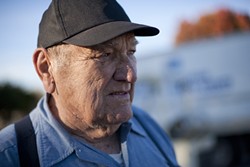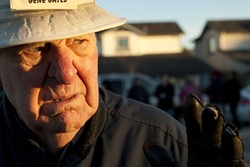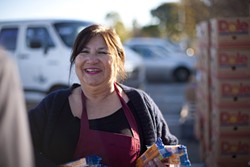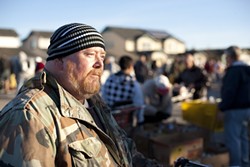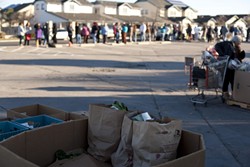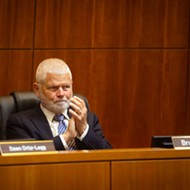The long, hard line
Hundreds of local volunteers work year-round to help thousands of hungry SLO County residentsHundreds of local volunteers work year-round to help thousands of hungry SLO County residents
By Colin Rigley[
{
"name": "Promo Temp Targeted",
"id": "PromoTempTargeted",
"class": "inlineCenter",
"insertPoint": "4",
"component": "15511697",
"requiredCountToDisplay": "0"
},
{
"name": "Ad - Medium Rectangle CC01 - 300x250 - Inline Content",
"class": "inlineCenter",
"insertPoint": "8",
"component": "15582119",
"requiredCountToDisplay": "12"
},{
"name": "Ad - Medium Rectangle LC01 - 300x250 - Inline Content",
"class": "inlineCenter",
"insertPoint": "18",
"component": "15582122",
"requiredCountToDisplay": "22"
},{
"name": "Ad - Medium Rectangle 9 - 300x250 - Inline Content",
"class": "inlineCenter",
"insertPoint": "28",
"component": "15582121",
"requiredCountToDisplay": "32"
}]
They start lining up in the cold and dark, hours before many people have even hit the snooze button. If you know what to look for, the signs are obvious: columns of people huddling against cold and wind, the buzz of forklifts, the scratching sound of packages and cans being shuffled in cardboard boxes.
A lot of people may have no notion of the immense machinery that comes together to feed thousands of needy people in this county; this writer certainly didn’t. And it’s not a once-per-year affair like the annual canned-food drives we all might remember from grade school.
On any given day, somewhere in the county, hundreds of volunteers are likely to get food to the people who need it. It’s a vast network comprising hundreds of moving parts, and in the end it may easily go unnoticed to anyone who isn’t a part of the system or dependent on it.
On a recent Thursday morning in Morro Bay, a few dozen people started climbing out of their cars to get a number. At this particular site—a part of one of seven countywide programs, each of which holds regular distributions, under the umbrella of the Food Bank Coalition of San Luis Obispo County—clients arrive to take a numbered ticket before lining up to receive whatever food there may be to collect.
Each program does things its own way, but typically people start arriving before dawn; they collect their ticket; they go back to their car to wait; they line up according to their number; and then they take whatever food is available.
At one of Morro Bay’s weekly distributions in November, clients packed together in tight groups to shield from the cold winds ripping off the bay. Some smoked cigarettes or traded packs of powdered cocoa and small Styrofoam cups of hot water. Others stood and held their place in line or hid behind doorways to shield from the wind.
When the truck arrived, a young man shoved his nose in the air and sniffed ceremoniously.
“Smells like meat,” he said to no one in particular.
It was much the same scene about a month later at the Arroyo Grande Harvest Bag Program where, at 7:30 a.m. and about 48 degrees, a few dozen people had formed a single-file line while they waited amid the beeping of forklifts and rattling of large trucks carrying stacks of pallets piled high with boxes of produce, dairy, and other miscellaneous food items.
“This is a short line right here, but it will probably get pretty long,” said Sieño Castillo, a volunteer from Mercy Church and one of a handful from the church’s Dream Center of the Central Coast, who have been working with the Food Bank Coalition since the summer.
He gestured toward the line: “You see a lot of the same faces. Some of these people actually take food to their neighbors.”
A few feet away, Eloise Kohal was shuffling tubs of sour cream onto a table.
“Lucy, I need bread,” she shouted to another volunteer.
Eloise and her husband, John, have been volunteering for a combined 53 years. She started volunteering with her husband after retiring because, as she put it, “I just wanted something to do.”
John said, “I started because my wife started.” But he’s continued to volunteer daily for 25 years.
“If I wasn’t doing this, I’d probably be dead by now,” the 86-year-old man added.
During her time as a volunteer, Eloise has done it all. She’s helped with home deliveries, worked in the warehouse, gathered donations from area stores, and even gleaned vegetables from local farms back when that was a major source of food for such programs.
But after 28 years of volunteering, does she ever think of, well …
“Quitting?” she said, her eyes suddenly wide and accusatory. “No! I enjoy what I’m doing and I plan on continuing.”
The Food Bank needs people like the Kohals, volunteers who show no signs of stopping. But in Arroyo Grande, at least, that pool of volunteers is in danger of drying up.
Robert Evans, a volunteer of three years and one of the coordinators at Arroyo Grande’s distribution site, said a lot of his helpers have been volunteering for as many as 30 years, and a lot of them are getting to the age where they won’t be able to do it much longer. If you factor in the poor economy where people are retiring at a later age, it’s becoming increasingly harder to find volunteers. Evans estimates he’ll lose about half of the Arroyo Grande team over the next five years.
“We’re just not getting the backfill,” he said. “It’s a struggle trying to get this thing going. … That would be the case with all volunteer organizations.”
Overall, though, the Food Bank programs around the county are trucking along with greater numbers than ever before.
You probably won’t find much creamed corn or old pie mix at one of these distribution sites.
“This is a very unique service,” Evans said, meaning the Food Bank and its affiliated agencies—church pantries, recovery programs, after-school programs, homeless shelters, and soup kitchens, for example—work to distribute a wide variety of food like fresh fruits and vegetables, some canned goods, meat when it’s available, and other items like grocery store sandwiches and deserts. They give out basically whatever they can get, making Food Bank distribution sites look more akin to a shanty-town grocery store than anything else.
“The Food Bank is set up like a super market for not-for-profit organizations,” Evans said.
More than 200 nonprofit agencies now coordinate under the wider Food Bank umbrella, up from 20 partners in 1989.
In the 2009 fiscal year, the Food Bank had total revenue of about $10.9 million, most of which went to cover about $10.2 million in expenses, according to a recent tax filing. Those expenses help pay for a grand total of 23 employees; two warehouses in Paso Robles and Oceano; and a fleet of 13 vehicles, eight of which are refrigerated, to transport nearly 5 million pounds of food per year.
About 20 percent of that food comes through donations from local stores, which receive tax breaks in exchange for unloading any food that’s still fresh but is about to go out of its code date, or other items that customers just aren’t buying. Other organizations donate food, too, such as Feed America and the California Association of Food Banks, which accounts for about 40 percent of the donated food, according to Associate Director Wendy Lewis.
Everything else is bought, usually for pennies on the dollar, from local distributors. Such purchases are made using money collected during Food Bank fundraisers. Despite being a multi-million dollar enterprise, most of the money goes back into the program. In 2009, for example, salaries and benefits accounted for about 5.7 percent of the Food Bank’s total expenses.
So in order to move all that food—to gather, sort, and distribute it—the Food Bank leans on a team of as many as 800 volunteers.
“Without these volunteers, there would be no Food Bank,” Lewis said.
As the food was being distributed in Arroyo Grande, volunteers at the Oceano warehouse a few miles away were wrapping up for the day. Bert Berringer was president of Harvest Bag before the group merged with the Food Bank Coalition in 2006 to stay alive. Now he helps oversee food collection, sorting, and distribution at the Oceano warehouse.
Volunteers scuttled around the building located near the railroad tracks in Oceano, trucking pallets of produce and dairy, and sorting food into individual grocery bags. At a glance, it’s not that unlike a grocery store: There are shelves lined with canned goods, boxes of produce, and a few cold-storage containers for meat and other perishable items.
That day, Berringer said the warehouse had put together close to 600 bags for its clients.
Perhaps more staggering than the vast network of trucks, warehouses, and volunteers, are the people for whom that system was created. At least 40,000 people in San Luis Obispo County received food in 2011, according to the Food Bank’s early estimates based on signatures taken at distributions sites and quarterly reports from more than 200 agencies that receive distributions. About five years ago, there were only about 24,000 clients.
“They need this, and with this horrible thing that’s happened in the whole damn world now, we’ve increased people,” said Gene Gates, a volunteer of 25 years who has overseen distribution to disabled clients in Arroyo Grande for the last 15 years.
Anyone with an annual income of $10,890 and below is considered to live in poverty in the United States. And according to the 2010 U.S. Census, more than 36,000 SLO County residents fell below that line, accounting for 14.3 percent of the county’s population. Although such a percentage is less than the statewide average (15.8 percent), consider that all of those people would outnumber the population of Paso Robles.
Food supply can fluctuate constantly, and the people who depend on it are often desperate when distributions come in shorter than usual. Meat and other proteins are perhaps the most coveted items—and also the hardest to come by. While other types of food come through multiple sources, meat is only acquired through store donations. It’s also the item that leads to the most complaints.
Clients who feel they’re getting shortchanged sometimes complain that the food is being distributed inequitably. Executive Director Carl Hansen said the Food Bank does get the rare complaint, and each one is treated seriously and immediately. But, he added, they do their best to make sure food is distributed as equitably as possible. Sometimes, though, the perception of inequity can be enough.
“We always need a lot more meat than we’re able to get,” Hansen said.
There’s no archetype for a Food Bank client; they can range from elderly people on a fixed income to people with disabilities, or just anyone who’s fallen on hard times. And while some clients show up regularly, others may come just a few times to get back on their feet.
As one client, who asked not to be named, said, “It’s very difficult to go to a place and wait in line to get food.”
Doug Britton has been standing in line for about a year, and he wishes he didn’t have to anymore, but “there’s basically no work.”
Britton is a construction worker who’s been unable to find any work in the current market. He picks up jobs when he can, even babysitting when he has to.
“Basically, I will do anything for money depending on how much money they’ve got,” he said.
For the time being, Britton’s living on his mom’s couch. He waits in line for food mainly so he can bring something into the house—so he can still contribute. In fact, Britton and his brother helped build the house about 10 years ago.
“I built the house I’m now sleeping on the couch in,” he said.
Over time, he’s become more accepting of the idea of coming to the Food Bank for help, even if it was difficult at first. There’s a camaraderie that comes with waiting in line alongside people who are all in the same boat, he said. They chat and often trade rumors about potential work.
Britton’s still looking for work, even though some people he knows have given up. And, for better or worse, he said, standing in line gets easier over time, “less embarrassing.”
“You spend a lot of time being poor finding out how to be poor better,” he said.
For the time being, Britton will keep getting up before the sun rises and arriving at the distribution site at around 6 a.m. so he can bring food back for himself and his mother.
“Every day, I wake up with a positive attitude,” he said shortly before taking a shaky shopping cart full of food back home. “I’ve redesigned my idea of a win. Winning means I’m not sleeping under a bridge somewhere.”
Not long ago, Lucy Escarcega was in a similar situation. She was diagnosed with ovarian cancer in 2008 and underwent treatment until 2010. Each treatment cost about $1,500, and as her medical bills racked up, she was forced to get her meals from the Food Bank.
But by late 2009, Escarcega started volunteering herself, “So I could feel good about myself, go out and do something instead of just staying home and feeling sorry for myself.”
Now she volunteers four days a week, both at the distribution site and at the nearby warehouse.
She wandered back and forth, moving boxes of cheese and rice pudding to a table for clients. It was just the beginning of her day. In addition to her volunteering, Escarcega holds two part-time jobs: one at a bridal shop and another working retail in the evenings.
“After I’m done here I go home and I get ready and I go to work,” she said, as if it wasn’t much of a task for anyone, let alone a cancer survivor.
“Get involved, give to your community, and your community will give to you,” she said. “It made me stronger. I’m in remission. What more could I ask for?”
News Editor Colin Rigley can be reached at [email protected].
Do you think the SLO County Board of Supervisors should have gone against their policy that states funding for independent special districts should not result in a net fiscal loss to the county?
Latest in News
Readers also liked…
-

SLO police identify alleged driver who hit and killed couple
Dec 22, 2022 -

When the levee breaks: Oceano residents, county officials walk a tightrope of regulations to manage Arroyo Grande Creek, which some say led to the levee's failure in January
May 18, 2023 -

Cal Poly report highlights offshore wind's potential to spur green energy transition
Jun 8, 2023

